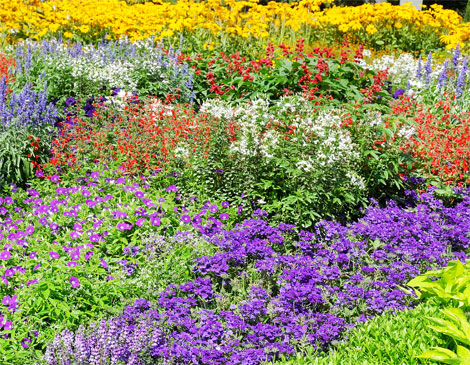Standing between rows of lush green plants in heady bloom, the steamy fragrance of just-watered soil wafting from the nursery benches, the question looms: How many is too many?
Give me credit for asking, at least.
But the lady next to me is arranging pots of bright orange nasturtium and purple salvia in her cart, and I think: Must. Have.
It's a slippery slope from there, and I haven't hit the herbs or vegetables yet. I should know better.
Twenty years ago, I had four large perennial beds and a 1,300-square-foot cutting garden. A vague notion of turning a mainly volunteer flower arranging practice into a cottage business initiated this horticultural adventure, but mostly I wanted lots of flowers. After some exhaustive research, I gravitated from casual sketches of the layout to carefully ruled diagrams on graph paper, with lists of blooming plants noted in the margins.
Improbably, that garden came to life one late-winter night when, pictures of tulips dancing in my head, I crept outside in a coat and heavy boots. I walked its imagined boundaries in deep snow under the light of an unusually bright moon. Here are the rows of Asiatic lilies, I thought. Here are the larkspur, yarrow and iris.
Come spring, my whole family assembled to roll back the cut sod and till the unexpectedly rich soil. I paid all the children a nickel for every rock and pebble they pulled from the dirt (Or was it a penny? I hope not. I do remember they quickly tired of that enticement). We picnicked under the big maple tree on sloppy Joes and potato chips my mom brought.
The garden had its moments of stunning beauty. My neighbor brought her bridge club to exclaim over the chest-high lilies in lush sunset colors. I took great pleasure arranging mixed bouquets for friends, local events and my own kitchen table.
But the deer and groundhogs were voracious. An insidious rampage of thistle sneaked in by way of a trailer full of horse manure and inflicted a chokehold around the roots of every plant.
I had overestimated the value of my homegrown flowers compared to truckloads shipped in from faraway places. And my toddler was forever drawn to the mostly ineffectual low-voltage fence around the perimeter. Within a few years, it became clear that this version of gardening felt more like farming.
One morning, my son and I headed out to harvest some long-anticipated late purple tulips, just coming into bloom. What we found was a row of 300 stiff green stalks, each blossom nipped off by deer like convenient bite-size candies. That evening when my husband arrived home from work, my son rushed to him with the news: "Mommy said a bad word about the deer!"
The great tulip massacre did me in. I couldn't maintain the lovely vision I had mapped out that snowy night, every row luminous, sparkling with possibility. All the joy had drained away from it. I threw in the trowel.
Anybody who owns a spading fork approaches the spring planting rush with a mix of anticipation and dread. The banquet of living, blooming plants after a bleak Northeast Ohio winter is nearly irresistible, like an all-you-can-eat buffet after dieting.
It's taken me years to shop realistically for plants. Still, I often fail. Inevitably there are flats of sad, orphaned annuals suffering behind my garage that finally get tossed on the compost pile with great remorse and guilt. Even if I manage to get all the plants in the ground, am I really interested in weeding and watering in July?
Those balmy days of spring spent digging in the dirt are flush with romance, a daydream of color winding through the landscape. Then the ground turns so hard it cracks, and sweat rolls down your back just walking to the mailbox.
The cutting garden long ago got parceled out and turned to meadow. All that remain are three clusters of Siberian iris, foliage poking up like swords among the slender grasses, surprising me each May with splashes of purple and white. I look at them, and my innocent enthusiasm from those years, with a kind of benevolent fondness.
With each passing growing season, my gardens hug closer to the house: a porch full of flowers cascading from planters; two 6-by-8-foot plots behind the deck for annuals, tomatoes and herbs; a simplified perennial border edging the short brick walk to the door. It's just enough work to satisfy, plenty to enjoy, not too much cleanup in the fall.
Georgia O'Keeffe said, "Nobody sees a flower really; it is so small. We haven't time, and to see takes time — like to have a friend takes time."
Letting go of a larger landscape has paradoxically given me more to see. What I have left I can truly give my attention to.
In some ways, I'd rather visit gardens now than plant them — an idea that astonishes me. It's enough, really, just to take them in. Some day, my idea of "enough" may turn out to be three perfect blooms of Casa Blanca lilies in a vase on my kitchen counter, picked up at the grocery store, trucked in from someone's fertile acres.
I'll admire them with equal parts joy and respect. Somewhere, a farmer has labored long and hard to bring them here.




